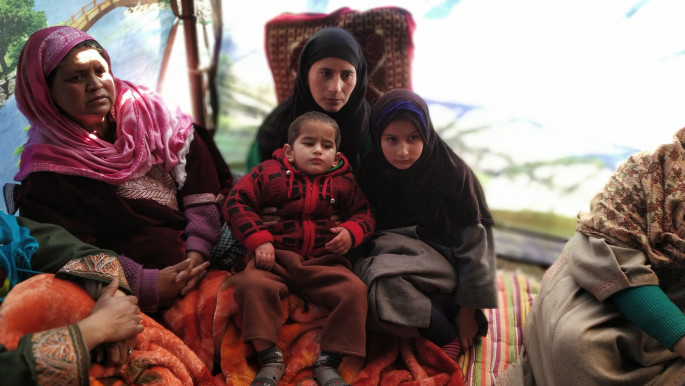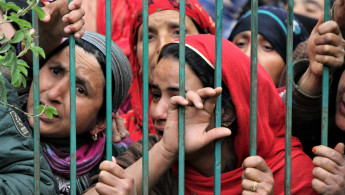Women hit worst by Kashmir's continuing conflict
A bullet pierced the tin sheet wall and pierced Firdousa's throat. She fell to the ground. Amid roaring gunshots, Firdousa's husband Khursheed Ahmad Sheikh and her sister-in-law Asmat Jan scrambled outside. They brought Firdousa into the house's corridor.
Blood was oozing from the wound. Her children, Aalima and Tawqeer, both under 10, squatted near her.
The 28-year-old Firdousa was moving her eyes between Aalima and Tawqeer. Her lips were trembling, and tears were rolling down her face. She wanted to speak but had lost her voice.
"Firdousa was dying before us. When the shooting stopped after half an hour, we rushed her to District Hospital Pulwama, but she succumbed on her way," Asmat told The New Arab. "A single bullet took two lives that day."
Firdousa's house was adjacent to the local Indian army base. Police said Firdousa had died in the cross-fire when militants attacked the 44 Rashtriya Rifles camp.
Every year, March 8 marks International Women's Day. This day plays a significant role in highlighting gender inequality and women rights. But how do women live in the world's largest militarised zone, Indian-administered Kashmir? What about their human rights?
 |
Frequent death and destruction cause stress in women which in turn affects maternal health |  |
Are the women of this disputed Himalayan region free from violence? Are they being treated well by the state and the larger society? Do they feel secure? The answers, for the most part, are depressing.
Indian-administered Kashmir has seen death and destruction since the armed insurgency erupted against Indian rule in 1989.
The death toll has already surpassed more than 70,000, with thousands more "disappeared". Yet more thousands have lost their eyesight due to the indiscriminate nature of the Indian military's shot-gun pellets.
 |
|
| Kashmiri children and their mother, who was widowed last year due to the conflict [Aamir Ali Bhat] |
But how has this deadly violence impacted Kashmiri women? In the past 30 years of armed conflict, women of Indian-administered Kashmir have suffered the brunt of the conflict. They are the victims of both direct and indirect systemic state violence.
On one side, Indian forces have been accused of rape, molestation and other sexual abuses. On the other, the extrajudicial killings, torture and enforced disappearances of their fathers, husbands, sons and brothers by Indian troops continue to haunt the women of Kashmir.
In the past eight years, the region has seen renewed extensive and popular uprisings against Indian rule, especially since the student-turned-armed-rebel-commander Burhan Wani was killed in July 2016.
 |
The highly patriarchal set-up of Kashmiri society places a double burden on Kashmiri women |  |
Last year was the deadliest in a decade. According to rights group Jammu Kashmir Coalition of Civil Society (JKCCS), 586 people including civilians, armed rebels, Indian armed forces and police were killed in 2018.
Like Firdousa, scores of women, mostly school-aged, lost their lives in 2018. Hundreds received pellet injuries. Thousands are still in shock, mourning the death of their loved ones.
Mahjabeen keeps fighting off flashbacks. The 28-year-old lives in Kular village in south Kashmir's Islamabad district. On 11 April 2018, her life was shattered when her 30-year-old soon-to-be husband was shot dead by Indian troops.
Her fiance, Sharjeel Ahmad, a driver by profession, was killed a fortnight before his wedding day. He had gone to a friend's house in Khudwani village, where a gunfight broke out between armed rebels and Indian armed forces.
Sharjeel was hit with two bullets when he stepped outside to use a washroom.
 |
|
| 12-year-old Andleeb Ali (L) and 14-year-old Muskan Nabi Wani were both shot dead in 2018 [Aamir Ali Bhat] |
On the night of 22 January 2019, Ishrat Muneer Bhat was shot dead at point-blank range by unknown gunmen. Ishrat's execution video went viral on social media and sent shockwaves across Indian-administered Kashmir.
Ishrat, a resident of south Kashmir's Pulwama district, was pursuing a Masters degree in sociology.
Police said Ishrat was killed by militants - but no armed group has taken responsibility for her killing.
Despite the decades-long military onslaught to crush the dissent of Kashmiri people, the women of Kashmir have always remained at the forefront of resistance.
Sima Akhter was a teenage girl when she shielded her armed insurgent brother Sameer Ahmad.
On 4 January 2018, Sameer had come home to visit his family. When the Indian armed forces surrounded their home, Sima confronted the troops to ensure her brother was given safe passage.
 |
Among the thousands registered as living with Post-Traumatic Stress Disorder (PTSD) in Kashmir, most are women |  |
Sima was shot down by the Indian troops who then killed her brother in a brief gunfight. She had recently passed her 12th Standard with 73.6 percent in medical subjects. She had dreams of becoming a doctor.
Not far away from Shopian is a village named Rewani in Kulgam district. In 2018, two schoolgirls - 14-year-old Muskan Nabi Wani and 12-year-old Andleeb Ali - fell prey to the ongoing violence.
Andleeb was shot dead outside her home on 7 July by government forces, while Muskan received a bullet in her head when she peeked through a window during a gunfight on 22 November.
Andleeb's 16-year-old sister, Khushboo Jan, has suffered depression and anxiety, having watched her younger sister be killed.
Read more: War averted. What now for Kashmir?
The deaths of Muskan and Andleeb severely affected their classmates. They still find it difficult to get over the shock.
"Andleeb was most dear to me. We used to go to school together," said one friend who asked to remain anonymous. "Sometimes now when I leave for school, I forgot for seconds that she is no more. I went to call for her. It hurts when I remember Andleeb is no more with me."
The consequences of such a long-running armed conflict are visibly seen in Kashmiri women. Among the thousands registered as living with Post-Traumatic Stress Disorder (PTSD) in Kashmir, most are women.
The frequent death and destruction have caused stress in women which in turn affects maternal health.
Alongside the long-running conflict, the highly patriarchal set-up of Kashmiri society places a double burden on Kashmiri women.
Being a part of a highly discriminatory and male-oriented society, women in Kashmir continue to be maltreated both at home and outside. In every sphere of life, women face both physical and psychological oppression - from gender inequality to domestic violence, harassment, discrimination, dowry-deaths and more.
According to the data compiled by National Judicial Data Grid, there are currently 12,173 cases related to women pending in courts across Indian-administered Kashmir.
Aamir Ali Bhat is a Kashmir-based freelance journalist who reports on human rights abuses, culture and the environment. He writes for The New Arab, Kashmir Ink and Free Press Kashmir.
Follow him on Twitter: @Aamirbhatt3





 Follow the Middle East's top stories in English at The New Arab on Google News
Follow the Middle East's top stories in English at The New Arab on Google News


